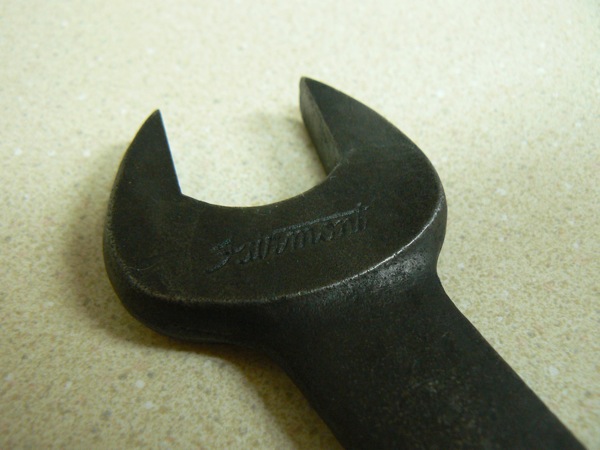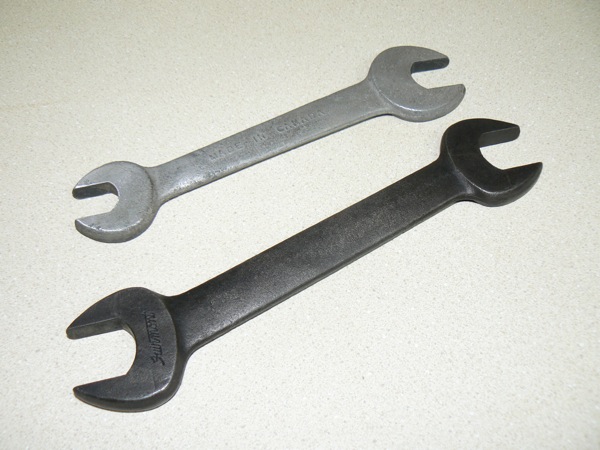I originally wrote this piece in 2009 as a forum post to the Old Woodworking Machines forum.
Rust Bluing
At my friendly neighbourhood randomness store, where you can buy cheese, a dusty can of beans, a used couch and a fist full old wrenches all at the same time, I found a couple rusty old double-ended wrenches. I love this style of wrench, on appearance alone–they have more character than your average chromed combination wrench. The sizes of the ends are usually not marked either, which makes them entertaining to use.
Anyway, these two particular wrenches were more ugly-rusty than patina-rusty, so I decided to “adjust the rust” until I had something that I liked. I didn’t think to capture a before photo, so just imagine a rusty wrench.
The Art of Rust: Removal
We’re all familiar electrolysis, and that’s what I did. I let it run for a longish time, stopping to rotate from time to time, and after hours of bubbling, I had a rust free wrench. I took my freshly de-rusted wrench inside, and commenced stage 2…
The Art of Rust: Putting Rust Back
I used a technique I discovered here - a mixture in the ratio of 1⁄3 c. hydrogen peroxide, 1 tbsp. vinegar and 1 tsp. salt was prepared in a plastic tray. I tossed my freshly de-rusted (and rinsed) wrench into the mixture. It immediately sprouted a fresh layer of rust, and started bubbling away. It seems that rust is born and dies in a cloud of bubbles. I let it rust for probably 30 minutes, then…
The Art of Rust: Converting Rust
I grabbed a pot from the cupboard, filled it with some water, and got it boiling. I took my now orange wrench, and dropped it in the boiling water. I let it sit there for about 1 minute. This is the neat part – very quickly, the orange rust turns black. I tossed the wrench on a cooling rack to cool, then took it to the sink. Using a worn out green scotch-brite pad, I scrubbed the loose black iron oxide off of the wrench.
I repeated the last two steps a couple times so that I could get a ‘deeper’ finish. My wife caught on to what I was doing in the kitchen with our pots and pans after the second run, and I had some ‘splainin’ to do. Needless to say I have to take a trip to the thrift shop to buy myself a pot. Anyway, I think the end result is impressive:


I gave it a coat of oil to prevent it from re-rusting too quickly.
For comparison, here’s a photo of the blackened wrench, with another one that is about to go through the same process:

Any time a person works with iron and steel, rust is always a problem. It was ‘empowering’ to be able to control it, and make it do what I wanted. Anyway, I just wanted to share – I was surprised with how easy it was to do rust bluing with things that almost every person has sitting around the house.
2019 Update
Almost 10 years later, the wrench still sits in my toolbox. It spent a few years in an unheated shed, then a few more years in my temperature moderated but still unheated garage, and it still looks as good as the day I wrote this.